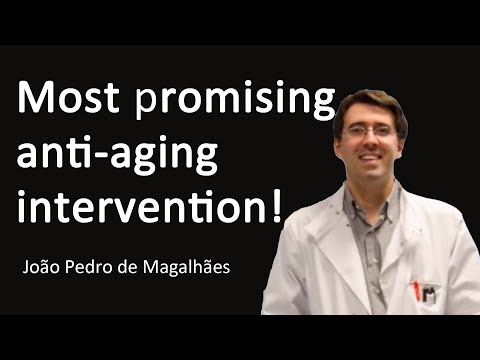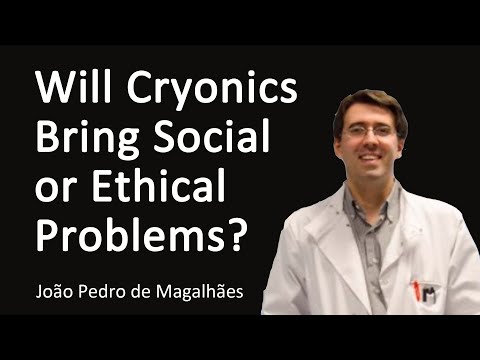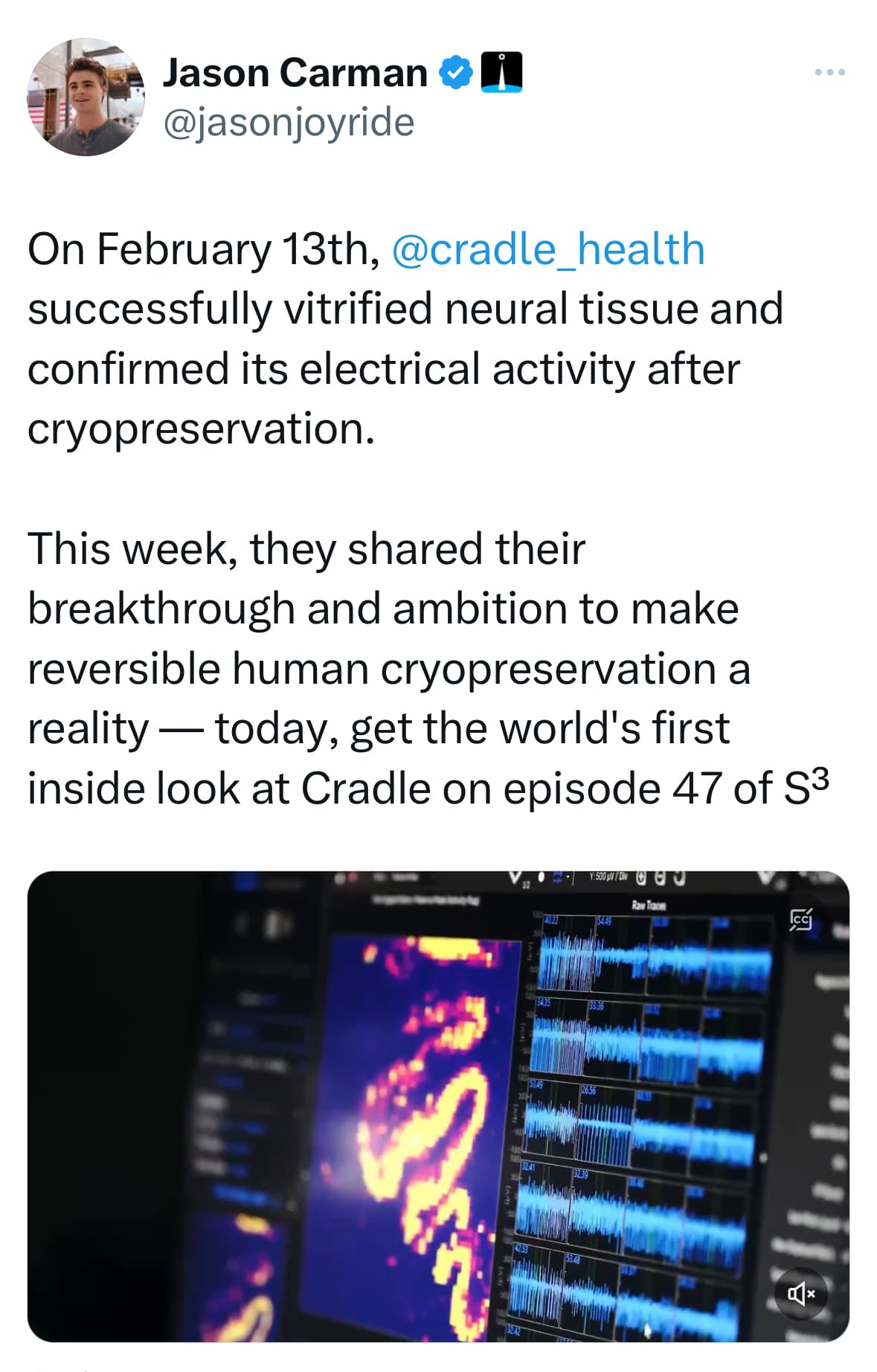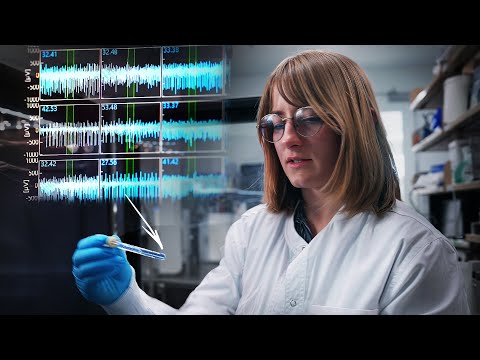I think there should be a rule that that only renewable energy can be used to power the freezers.
that is rather ridiculous . doesn’t take much power anyway if it is good insulation.
another main issue is doing so such that most all of ones memory is still intact for if not then it might as well be a new person for all the frozen and thawed one knows
Though cryonics has been practiced for forty years, its techniques have improved only slowly; its few customers can only induce a tiny research effort. The much larger brain research community, in contrast, has been rapidly improving their ways to do fast cheap detailed 3D brain scans, and to prepare samples for such scans. You see, brain researchers need ways to stop brain samples from changing, and to be strong against scanning disruptions, just so they can study brain samples at their leisure.
These brain research techniques have now reached two key milestones:
- They’ve found new ways to “fix” brain samples by filling them with plastic, ways that seem impressively reliable, resilient, and long lasting, and which work on large brain volumes (e.g., here). Such plastination techniques seem close to being able to save enough info in entire brains for centuries, without needing continual care. Just dumping a plastic brain in a box in a closet might work fine.
- Today, for a few tens of thousands of dollars, less than the price charged for one cryonics customer, it is feasible to have independent lab(s) take random samples from whole mouse or human brains preserved via either cryonics or plastination, and do high (5nm) resolution 3D scans to map out thousands of neighboring cells, their connections, and connection strengths, to test if either of these approaches clearly preserve such key brain info.
An anonymous donor has actually funded a $100K Brain Preservation Prize, paid to the first team(s) to pass this test on a human brain, with a quarter of the prize going to those that first pass the test on a mouse brain. Cryonics and plastination teams have already submitted whole mouse brains to be tested. The only hitch is that the prize organization needs money (~25-50K$) to actually do the tests!
Cryonics-oriented people may like this presentation…
Very short video on cryonics.
I for one find it super interesting and thanks for bringing it up. I’d want to try and talk my family members into it so I don’t wake up in 200 years with my whole family long dead
New Cryonics startup announced: Startup Brings New Hope to the Pursuit of Reviving Frozen Bodies (Bloomberg)
See also:
The money that immortality-chasers pour into longevity trends, both as consumers and patrons, is furthering real-world scientific progress. Even cryogenic freezing is less “Star Trek” than it sounds: human embryos are already cryopreserved as part of in-vitro fertilization. In the future, cryogenic freezing could help store human organs, keeping them viable longer for transfers. It could also save and revive endangered species.
Don’t forget about space travel. Interstellar travel is dangerous and not practical as of now, but with cryogenics we can send people on month, year or even century long missions to other moons, planets and star systems.
I think working out hibernation (which looks to be an option for the human genome) is more practical.
Think they both would be valuable, but for different things.
Hibernation can be key for trauma and critical care medicine and perhaps short space travel within our inner solar system as it will likely only work for a week, weeks or perhaps months.
That won’t be enough to fully transform organ transplantation, or for the “ambulance through time to better medicine” that might need years, or even decades, or for human kind to become a multi-solar system species (and have a chance to survive the expansion phase / death of our sun and many other existential risks) which might require hundreds, if not thousands of years of travel vast distances to other stars (if we don’t find ways to build warp drives). So for things like this we’d need indefinite stop of biological time that ice free, vitrification at cryogenic temperatures provides.
@DeStrider @Virilius @RapAdmin @desertshores @Olafurpall @tongMD @A_User
Here is a quite in-depth review of the field just published this past week
Prof George Church from Harvard University, Harvard Medical School and the Wyss Institute and Prof JP Maghales from Birmingham and Oxford University are among the senior co-authors
(Just note that the review has a bit extra focus towards toward so called “fluid preservation” (the focus area of the first author) which in my mind while cheaper does not have the same potential for real working “medical time travel” as ice-free cryopreservation via vitrification has)
Structural brain preservation: a potential bridge to future medical technologies
When faced with the prospect of death, some people would prefer a form of long-term preservation that may allow them to be restored to healthy life in the future, if technology ever develops to the point that this is feasible and humane. Some believe that we may have the capacity to perform this type of experimental preservation today—although it has never been proven—using contemporary methods to preserve the structure of the brain. The idea is that the morphomolecular organization of the brain encodes the information required for psychological properties such as personality and long-term memories. If these structures in the brain can be maintained intact over time, this could theoretically provide a bridge to access restorative technologies in the future. To consider this hypothesis, we first describe possible metrics that can be used to assess structural brain preservation quality. We next explore several possible methods to preserve structural information in the brain, including the traditional cryonics method of cryopreservation, as well as aldehyde-stabilized cryopreservation and fluid preservation. We focus in-depth on fluid preservation, which relies on aldehyde fixation to induce chemical gel formation in a wide set of biomolecules and appears to be a cost-effective method. We describe two theoretical recovery technologies, alongside several of the ethical and legal complexities of brain preservation, all of which will require a prudent approach. We believe contemporary structural brain preservation methods have a non-negligible chance of allowing successful restoration in the future and that this deserves serious research efforts by the scientific community.
TimeShift : World’s first cryopreservation facility (Concept now) .
The project was unveiled on January 7, 2025.
Created by Dr. Alex Zhavoronkov, a generative AI scientist and anti-aging researcher, and Hashem Al-Ghaili.
TimeShift is described as the world’s first cryopreservation facility and is based on cutting edge AI and new cryopreservation techniques. The concept could allow cancer patients to wait in stasis for medical advancements or even for humanity to outlive apocalyptic disaster. The system would even use AI to let your digital avatar communicate with loved ones during cryostasis.
The main points are about using AI to improve cryopreservation and the challenges of scaling it for humans.
Here are the main points from Mark Woodward’s talk, “Freezing People with AI” at the AI X Bio Workshop 2025:
1. Background and Motivation
- Mark Woodward has a PhD in computer science, focusing on machine learning and AI. He previously worked at Google Brain, which merged with DeepMind.
- He decided to apply AI to something he felt was more meaningful: cryonics.
2. Cryopreservation Example
- He shares the story of Lydia and Timothy, embryos frozen for 30 years (since 1992), thawed in 2022, and now healthy toddlers. This demonstrates that low temperatures can halt biology for decades.
3. The Problem of Death
- About 60 million people die each year, and most—even those in hospice—would prefer to keep living.
- Even as longevity technologies advance, there will always be cases where preservation is needed as a “safety net.”
4. Technical Challenges in Human Cryopreservation
- Scaling up from embryos to whole humans is difficult because humans are much larger.
- Thicker tissue means slower heat transfer, which increases the risk of ice formation—ice damages cells.
- Preventing ice requires higher concentrations of cryoprotectant chemicals, but these become toxic at high levels.
5. Wake Bio’s Approach
- Woodward’s company, Wake Bio, founded in January, is working on preserving adult organisms, starting with zebrafish.
- They use AI to identify new, less toxic cryoprotectants and to optimize preservation parameters (like cooling rates and annealing phases).
- Their process involves rapid experimentation, feeding results back into machine learning models to guide the next experiments.
6. Call for Collaboration
- Wake Bio is seeking investors and organic chemists to help advance their work.
7. Q&A: Why Focus on Cryonics?
- Woodward sees cryonics as a necessary safety net alongside other longevity treatments, motivated by a desire to provide an option for those who “slip through the cracks.”




